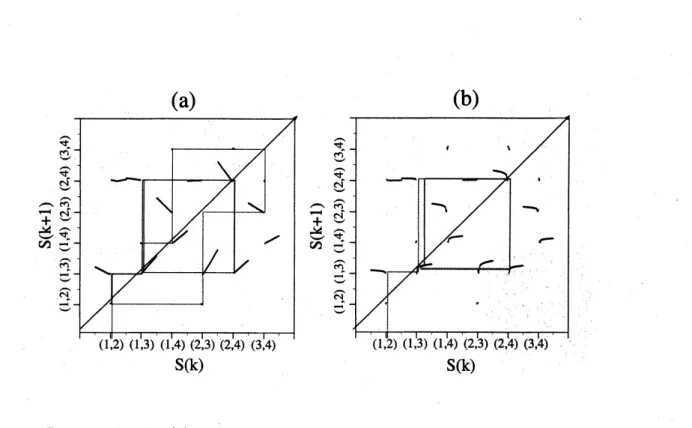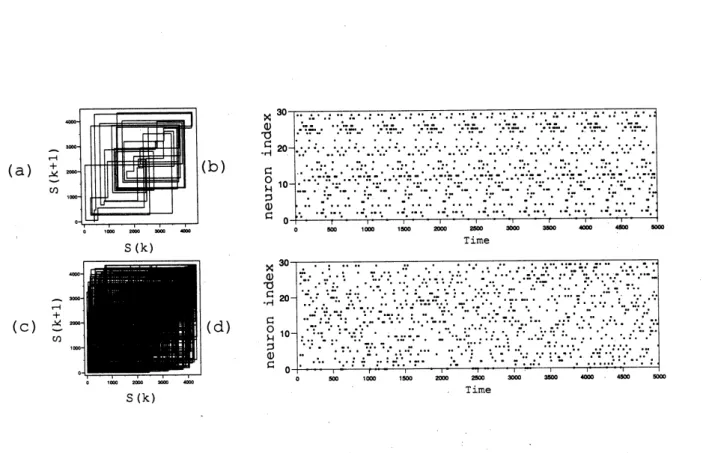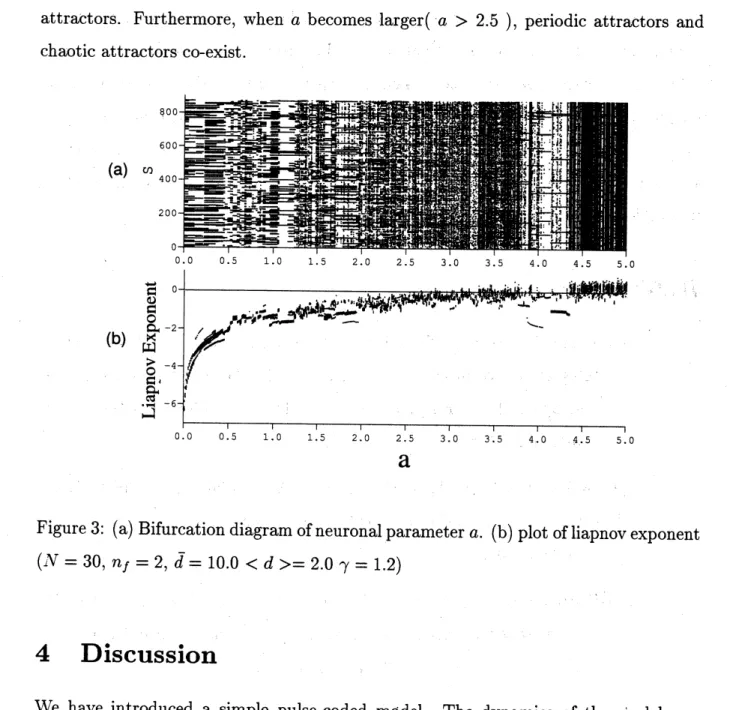A Simple Neural Network
Model for
Temporal
Pulse
Coding
東大工学部計数数理–研
&CREST
渡辺正峰 (Masataka Watanabe)東大工学部計数数理–興
&CREST
合原–幸 (Kazuyuki Aihara)1
Introduction
In recent years there has been renewal of interest in the basic coding principle of the brain, how information is transmitted among neurons. Today, there are two major hypothesis: rate coding, where the mean firing rate is the carrier of information, and temporal coding, where timing of individual pulses are the carriers of information.
Rate coding hypothesis has been the established theory for a long time and most
model approaches aswell as many experiments on biological networks have been based
on this idea. This hypothesis was widely accepted due to the existence ofa
quantita-tive relationship between the firing rates of single cortical neurons and psychophysical judgments made by behaving monkeys(Barlow 1987; Newsome 1989; Britten 1992).
On the other hand, spatio-temporal coding has been recently brought to light by both biologists and theorists. Softky and Koch (1993) reported that the inter-spike
in-tervals of cortical pyramidal cells are highly variable and concluded that
neurons
func-tion
as
coincidence detectors which indicates temporal coding. Furthermore, Vaadiaet.$al$ observed the dynamical modulation of temporal relations between the discharges
of neurons in the monkey prefrontal cortex in response to contexts or external events,
leading to the idea that information is contained in the spike timing(Vaadia 1995). On
the theoretical side, Abeles proposed the notion of “synfire chains” which as
sures
thetiming accuracyof neuronal firings observed in brains of behaving monkeys with rather
unreliable
neurons
$(\mathrm{A}\mathrm{b}\mathrm{e}\mathrm{l}\mathrm{e}\mathrm{s}1993\mathrm{b})$. Besides this, many other experimental results andtheoretical considerations support temporal pulse coding in the brain($\mathrm{s}_{\mathrm{a}\mathrm{k}}\mathrm{u}\mathrm{r}\mathrm{a}\mathrm{i}$ 1993;
We believe that the truth lies somewhere in the between of pure rate coding and
pure temporal coding. However, we feel that it is also necessary to simplify things in
order to carry out theoretical studies, such as viewingthe coding ofthe brain fromthe two extremes, the rate coding and temporal coding hypothesis. The problem is that there seems to be onIy few fundamental models whichgive a mathematicaldescription of the underlying dynamics in temporal pulse coding. Whereas in the rate coding paradigm, say, we have the Hopfield model(Hopfield 1982). Hopfield introduced the notion of “energy” in a single layer neural network and showed that the neuronal dynamics evolves
so
thatenergy
decreases with time.The purpose of this paper is to introduce a simple model which describes
mathe-matically the ongoing dynamics of temporal pulse coding. That is to say, we will try to purely extract the effects of incident pulse timing on network dynamics and also make it simple enough for theoretical analysis. To be more specific, we eliminate the effects of spatial summation of neuronal activities, which was the key to rate coding, by using “uniform” synaptic strength on amutually connected network. Also we make
several assumptions
so
that weare
able to define “network state”in such continuous time systems and thus describe the dynamics by iteration of maps.We will first give the descriptions of the proposed model and next analyze the model by
means
of numerical simulation from the aspects of dynamical stability and basins of attraction. Furthermore, we introduce a learning rule which increases the stability and basin ofattraction of attractors in our proposed model. Final section is assignedto discussions.
2
Neural Network Model
The network model is a deterministic point process model $\mathrm{b}\mathrm{a}s$ed on temporal pulse
coding. That is to say, pulses actually propagate among neurons with finite delay, and
neurons
workas
coincidence detectors of incident pulses. Furthermore, in orderto extract the effect ofincident pulse timings
on
neuronal interaction, weassume
thatneurons are
mutually connected with “uniform” synaptic efficacy. This corresponds tothe
case
where onlyone
pattern is embedded in the network by the Hebbian learningrule, whichis not very interestingfrom theview point of classical ratecoding. However, in atemporal pulse coding network model, by assuming random time delay for pulse propagation, it has been reported to show various dynamics($\mathrm{w}\mathrm{a}\mathrm{t}\mathrm{a}\mathrm{n}\mathrm{a}\mathrm{b}\mathrm{e}$ and Aihara
(1997), Watanabe et. $al$ (1998)$)$
.
Before giving equations and going into the details of the model, we take up the two assumptions which
we
make to constructa
“simpleas
possible” model. The firstis that neuronal firings
are
localized in time. We realize this by setting the varianceof pulse propagation delay small enough so that pulses sent from a
group
of firingneurons
do not spread out in time and overlap with pulses sent out from other groupsof neuronal firings. We call this group of pulses, “pulse group” As a consequence,
localized neuronal firings become
a
function ofthe previous localized neuronal firings,that is to say, it becomes possible to describe the network dynamics in discrete steps
of pulse
groups.
The second assumption is to fix the number of firing
neurons
resultingfrom asingle pulsegroup.
Weassume
some
kind ofa
negative feedbackloopwhichkeepsa
moderaterate of activity in the network. As a consequence, the network state becomes a fixed
dimensional vector and the dynamics
can
be written as iterations ofmaps.Now that
we are
ready,we
willgo
onto the details ofthe model, first in the generalcase.
We define $\mathrm{t}^{f}(k)$as
the neuronal firing time vector with firing time of $N$neurons
in the $k\mathrm{t}\mathrm{h}$ pulse
group
as its components.As we stated earlier, only $n_{f}$
neurons
firein a single pulse group, so $n_{f}$ components have actual firing time as its value and rest
will be “$- 1$” indicating
that the
neuron
did not fire in the $k$ th pulse group. Fromthisneuronalfiringvector, matrixof pulse arrivaltime in the $k+1\mathrm{t}\mathrm{h}$pulse group $\mathrm{T}^{P}(k+1)$
$\mathrm{T}^{p}(k+1)=F(\mathrm{t}^{f}(k), \mathrm{D})$, (1)
where function $F$ adds pulse propagation delay given by the delay matrix$\mathrm{D}$ to the
neuronal firingtime
as
follows,$t_{ij}^{p}(k+1)=\{$
$t_{j}^{f}(k)+d_{ij}$, $\mathrm{i}\mathrm{f}t_{j}^{f}\geq 0$,
$-1$, $\mathrm{i}\mathrm{f}t_{j}^{f}=-1$
.
(2) Here, $t_{ij}^{p}(k+1)$ and $d_{ij}$ are the components ofmatrix $\mathrm{T}^{p}(k+1)$ and $\mathrm{D}$, denoting
pulse arrival time and pulse propagation delay from pre-neuron $j$ to post-neuron $i$, respectively.
Given the pulse arrival time of all neurons in the network, the neuronal firingtime
of the $k+1\mathrm{t}\mathrm{h}$ pulse group is determined,
$\mathrm{t}^{f}(k+1)=G(\mathrm{T}^{p}(k+1))$. (3)
Here, the role of function $G$ is to determine “which neurons” and “when” to fire
given the distribution of pulses. Thus the selection of this function decides the property
of a single neuron and the negative feedback loop for stabilizing activity. Taking
equations (1) and (3) into account, the overall dynamics of
our
modelcan
be written as$\mathrm{t}^{f}(k+1)=G\mathrm{o}F(\mathrm{t}^{f}(k), \mathrm{D})$. (4)
Next
we
describe the definite case used in the following simulations where,as
themost simple case, we choose the number of firing neurons in a pulse group $n_{f}=2$ and
function $G$ as described below.
The first part offunction $G$ is to decide which
neurons
to fire. Defining $\phi(1, k)$ andchoose the next two firing
neurons
with the smallest two incident pulse interval$(IPI)$as,
$IPI_{i}(k+1)=|t_{\phi(1,k),i}^{p}(k+1)-t_{\phi}^{p}((2,k),ik+1)|=|\triangle t^{f}(k)+d_{\phi(1,k}),i-d_{\phi(2,k}),i|$, (5)
$IPI_{\emptyset(1}1,k+)(k+1),$$IPI_{\emptyset}(2,k+1)(k+1)<IPI_{i}(k+1)(i=1, \ldots, N, i\neq\phi(1, k+1), \phi(2, k+1))$,
(6) where $\triangle t^{f}(k)=t_{\phi(1,k}^{f}()k)-t_{\phi(k}^{f}(2,)k)$. This method of choosing neurons to fire
reflects the idea that
neurons
act ascoincidence detectors of incident pulses in temporal pulse coding.Now that we know which neurons to fire in the $k+1$ th pulse group, the next role
of function $G$ is to determine “when” to fire. The firing time is a function of the local
information available to a neuron, the pulse arrival time, as follows,
$t_{i}^{f}(k+1)=(t_{\phi(1,k)}^{p},i+t_{\phi(2,k)}^{p},i)/2+a|t^{p}t_{\phi(2}^{p},|^{\gamma}\phi(1,k),i^{-}k),i(i=\phi(1, k+1),$$\phi(2, k+1)),$ $(7)$
where the first term of the right hand side takes the average of arrival time of the two pulses and the second term describes the firing delay depending on IPI. Larger the IPI, larger the firing delay. The two parameters $a$ and $\gamma$ characterizes the property of
the firing delay. These two values and the delay matrix are the only parameters in our
model and as we will see in the followingsection, especially $a$ has alarge influence
on
the network dynamics.
From equations(2) and (7), we get the following equation which corresponds to eq.
(4) in
the
general case,$+a|t_{\phi(1}^{f},-k)t^{f}+k)d_{\phi}(1,k),i-d_{\phi}(2,k),i \int^{\gamma}\phi(2$
,
$(i=\phi(1, k+\dot{1}),$$\phi(2, k+1))$. (8)
Moreover, subtracting $t_{\phi(1)}^{f}1,k+(k+1)$ from $t_{\phi(1}^{f}2,k+$
)$(k+1)$, we get
$\triangle t^{f}(k+1)$ $=$ $(d_{\phi(1,k)},\phi(1,k+1)+d\phi(2,k),\emptyset(1,k+1)-d_{\phi(}1,k),\phi(2,k+1)-d\phi(2,k),\emptyset(2,k+1))/2$
$+a|\triangle t^{f}(k)+d_{\phi(}1,k),\phi(1,k+1)-d\phi(2,k),\phi(1,k+1)|^{\gamma}$
$-a|\triangle t^{f}(k)+d_{\phi}(1,k),\phi(2,k+1)-d_{\phi(2},k),\phi(2,k+1)|^{\gamma}$. (9)
Notice that from equations (6) and (9), the iteration of the map only depends
on
$\triangle t^{f}(k)$ and $\phi(1, k),\phi(2, k)$. Therefore we can consider the network state of the $k$ th
pulse group as the following three dimensional vector,
$\mathrm{s}(k)=\{\triangle t^{f}(k), \phi(1, k), \phi(2, k)\}$. (10)
Furthermore, without losing generality, we can map this three dimensional state
space onto one dimension which makes it possible to view the mapping,
$S(k)=\Delta t^{f}(k)+\psi\{\phi(1, k), \phi(2, k)\}$, (11)
where $\psi$ is a function such as,
$\psi(i,j)=2\Delta t_{\max}^{f}\{(2N-1)(i-1)/2+j-i\}$. (12)
Taking equations (9)(11) into account, the overall dynamics of
our
network with$n_{f}=2$ becomes a
one
dimensional return map.. $s(k+1)=\Omega(S(k), \mathrm{D})$, (13)
$+a|s(k)-\psi\{\phi(1, k), \phi(2, k)\}+d_{\emptyset}(1,k),H_{1}(S(k))-d\phi(2,k),H_{1}(s(k))|^{\gamma}$
$-a|S(k)-\psi\{\phi(1, k), \phi(2, k)\}+d_{\emptyset}(1,k),H_{2}(s(k))-d\phi(2,k),H_{2}(s(k))|^{\gamma}$
$+\psi\{H_{1}(S(k)), H_{2}(S(k))\}$. (14)
where $H_{i}(S(k))(i=1,2)$ is afunction which determines what
neurons
to fire fromthe previous network state using equation (6).
3
Simulation
results
3.1
Change of
parameter
“$\gamma$
”-piecewise linear and nonlinear
A network of$N=4$
neurons
with uniform random delay $(8<d_{ij}<12)$ is studied inthis section to investigate the change of dynamics with parameter “
$\gamma$
”
First,
we
will look at the return map of network states when $\gamma$ is 2. In this case,$\mathrm{e}\mathrm{q}.(14)$ becomes,
$S(k+1)$ $=$ $2a(d_{\phi()}1,k,H_{1}(S(k))-d\phi(2,k),H_{1(S()}k))-d\phi(1,k),H_{1}(S(k))+d\phi(2,k),H1(S(k)))S(k)$
$+(d_{\phi(1,k)},H_{1}(s(k))+d_{\emptyset\{}2,k),H_{1}(s(k))-d\phi(1,k),H_{2}(S(k))-d_{\phi}(2,k),H2(s(k)))/2$
$+(d_{\phi(),(S}1,kH_{1}(k))-d\phi(2,k),H_{1}(S(k))))^{2}-(d\phi(1,k),H_{2}(s(k))-d\emptyset(2,k),H_{2(()}Sk)))^{2}$
$+\psi\{H_{1}(S(k)), H_{2}(S(k))\}=a\alpha(s(k), \mathrm{D})S(k)+\beta(S(k),\mathrm{D})$ , (15)
and since $H_{i}(S(k)$ stays constant for small changes of $S(k)$, it is a piecewise linear
return map. Figure(1)$(\mathrm{a})$ shows the actual return map for $\gamma=2$.
On the other hand, Figure(1)$(\mathrm{b})$ shows the case for $\gamma=1.2$ where it becomes a
$\mathrm{O}(\mathrm{h}/$ $\circ \mathrm{t}^{\mathrm{x}}J$
Figure 1: Returnplot for (a) $\gamma=2.0$, piece-wise linear caseand (b) $\gamma=1.2$, piece-wise
nonlinear $\mathrm{c}\mathrm{a}\mathrm{S}\mathrm{e}(N=4, n_{f}=2,\overline{d}=10.0<d>=2.0)$
3.2
Change
of parameter
“$\mathrm{a}$”-periodic,
chaotic
and complex
dynamics
In this subsection,
we
investigate the change of network dynamics with parameter $a$which first appears in $\mathrm{e}\mathrm{q}.(7)$. As
we can
see from $\mathrm{e}\mathrm{q}.(14)$, parameter $a$ gives themean
inclination of the map. Therefore, increasing $a$ works to raise the
average
gradient ofthe map, hence, the dynamics becomes less stable.
The neuronal firing of the network with two different $a$ is given in figure(2). As
we can see, the network dynamics is periodic for $a=0.5$ and chaotic for $a=5.0$.
Here we choosed 1.2 for $\gamma$ since the piecewise linear case $(\gamma=2.0)$ tends to break the
assumption which says that pulse
groups
should not overlap when $a$ takes largevalues.To get
a
whole grasp ofthe change of network behavior with $a$, we givea
diagramof bifurcation and lyapunov exponents in figure(3). Here, the lyapunov exponent is
(a)
3(K)
$\mathrm{S}(\mathrm{k})$
Figure 2: Return plot and Raster diagram $(\mathrm{a}),(\mathrm{b})$ periodic dynamics
:
$\mathrm{a}=0.05(\mathrm{c}),(\mathrm{d})$chaotic dynamics: $\mathrm{a}=5.0(N=30, n_{f}=2,\overline{d}=10.0<d>=2.0\gamma=1.2)$
$\lambda=1/K\sum^{K-1}logk=0|dS(k+1)/dS(k)|$, (16)
$dS(k+1)/ds(k)$ $=$ $a\gamma\{|S(k)-\psi\{\phi(1, k), \phi(2, k)\}+d_{\phi(1,k),(S}H_{1}(k))-d\phi(2,k),H1(S(k))|^{\gamma-}1$
$-|S(k)-\psi\{\phi(1, k), \phi(2, k)\}+d_{\emptyset}(1,k),H_{2}(S(k))-d\phi(2,k),H_{2}(S(k))|\gamma-1\}$
$=a\gamma\{|t^{p}-\phi(2,k),\phi(1,k+1)t_{\phi()}p|1,k,\emptyset(1,k+1)-\gamma-1|t_{\phi(}^{p}-1,k),\phi(2,k+1)t_{\phi(}p|^{\gamma}2,k),\phi(2,k+1)-1$
$(1_{\mathfrak{l}}^{r}$
Calculation for
a
single $a$was
started from100
distinct initial states and plottedafter transient$(k> 10000)$. As parameter $a$ increases, the lyapunov exponent
grad-ually rises and from the bifurcation diagram we
can see
that the network dynamics becomeschaotic. We should also notice the gap between multiple lyapunov exponents for single $a$ where they are negative. This indicates the existence of multiple stablelarger$(a>2.5)$ , periodic attractors and
chaotic attractors co-exist.
a
Figure
3:
(a)Bifurcation
diagram ofneuronal parameter$a$. $(\mathrm{b})$ plot ofliapnovexponent$(N=30, n_{f}=2,\overline{d}=10.0<d>=2.0_{\gamma}=1.2)$
4
Discussion
We have
introduced
a
simple pulse-coded model. The dynamics of the Modelwas
clarified using a return map and the lyapunov exponent, where existence of periodic
and chaotic attractors
were
confirmed. It is alsoimportant to note that multiplestableattractors exist in
our
model. We may consider these attractors as “memories”, asin the Hopfield model. We have also proposed a learning rule which decreases the
lyapunov exponent of
an
attractor and henceincreases
the stability and the basin ofAs we have stated earlier, this paper concentrated
on
the analysis of pure temporalcoding, in other words, we investigated only the effect of pulse timing
on
neuronalinteractions. Neuronal interactions, say, how
neurons
decide when to fire given theoutputs of other
neurons
in the network, is alsoa
function of whatneurons
fired. Thisis realized in the distribution of synaptic weights in usualmodels,whereas in
our
modelwe
used an uniform distribution. Combining temporal and spatial effecton
neuronalinteraction will be the subject of
our
future study.References
[1] Abeles, M., Prut, Y., Bergman, H., Vaadia, E., Aertsen,A.M.H.J. (1993b) Integration, synchronicity and periodicity. In: Aertsen A. (ed) Brain
The-ory: Spatio-Temporal Aspects of Brain Function. Elsevier
Science
Publ.,Amsterdam, New York, pp
149-181.
[2] Barlow, H.B., Kaushal, T.P., Hawken, M., Parker, A.J. (1987) Human
contrast discrimination and the threshold of cortical-neurons. J. Opt. Soc.
A, 4,
2366-2371.
[3] Britten K.H., Shadlen M.N., Newsome W.T., Movshon J.A. (1992) The
analysis of visual motion:
a
comparison of neuronal and psychophysicalperformance. J. Neurosci, 12,
4745-4765.
[4] Hopfield, J.J. (1982) Neural networks and physical systems with emergent collective computational abilities. Proc. Natl. Sci. USA, 79, 2554-2558.
[5] Newsome, W.T., Britten, K.H., Movshon,
J.A.
(1989) Neural correlatesofa perceptual decision. Nature, 341,
52-54.
[6] Sakurai, Y. (1996) Population coding by cell assemblies-what it really is in the brain. Neuroscience Research, 26,
1-16.
[7] Softky, W. R., Koch, C. (1993) The highly irregular firing of cortical cells
is inconsistent with temporal integration of random EPSPs. J. Neurosci,
13,
334-350.
[8] Vaadia, E., Haalman, I., Abeles, M., Bergman, H., Prut, Y., Slovin, H., Aertsen, A. (1995) Dynamics of neuronal interactions in monkey cortex in relation to behavioral events. Nature, 373, 515-518.
[9] Watanabe M., Aihara $\mathrm{K}.(1997)$ Chaos in neural networks composed of
coincidence detector neurons, Neural Networks, 10, 8,
1353-1359
[10] Watanabe M., Aihara K. and Kondo S. (1998) A dynamical neural net-work with temporal coding and functional connectivity,Biological Cyber-netics, 78,


